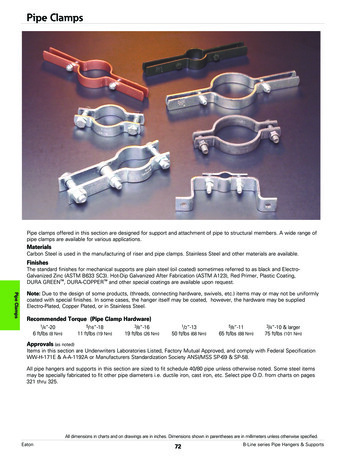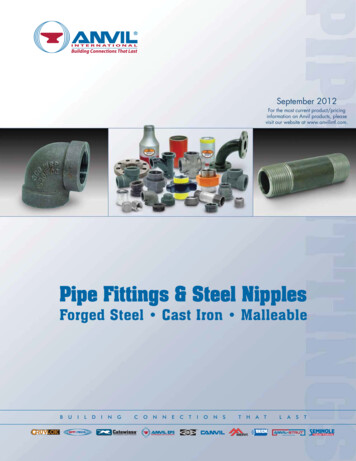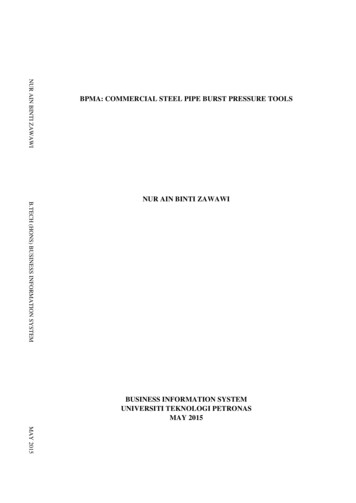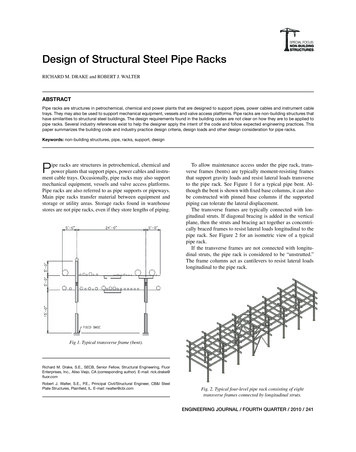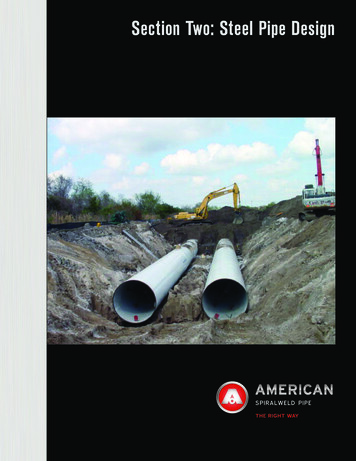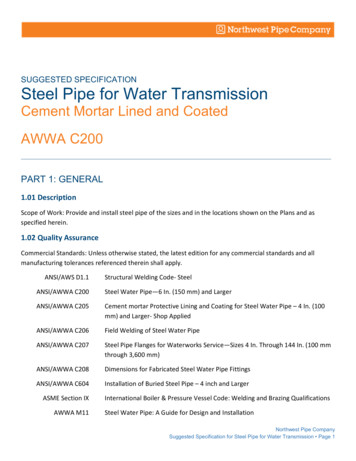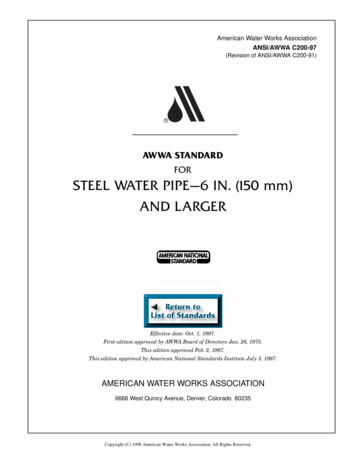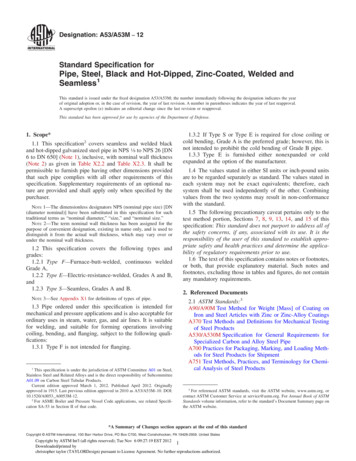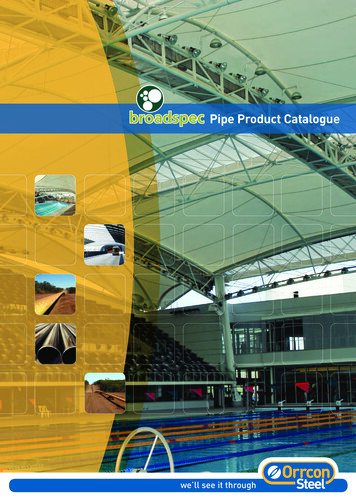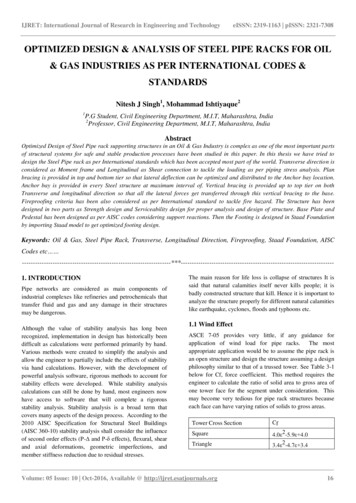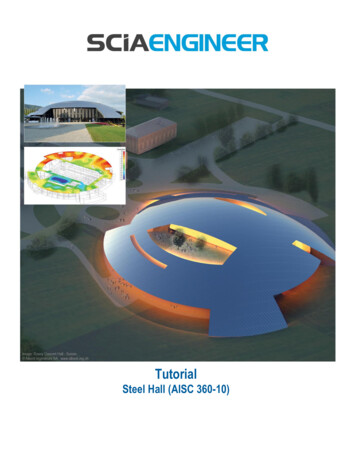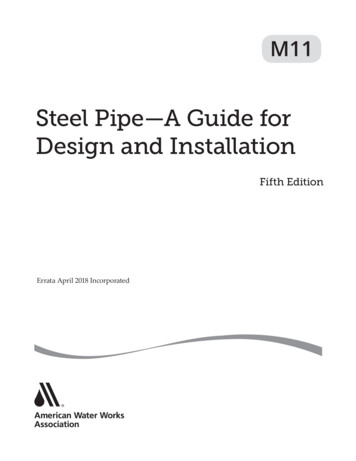
Transcription
M11Steel Pipe—A Guide forDesign and InstallationFifth EditionErrata April 2018 Incorporated
Manual of Water Supply Practices—M11, Fifth EditionSteel Pipe—A Guide for Design and InstallationCopyright 1954, 1972, 1983, 1991, 2000, 2012, 2017 American Water Works AssociationAll rights reserved. No part of this publication may be reproduced or transmitted in any form or by anymeans, electronic or mechanical, including photocopy, recording, or any information or retrieval system,except in the form of brief excerpts or quotations for review purposes, without the written permission ofthe publisher.DisclaimerThe authors, contributors, editors, and publisher do not assume responsibility for the validity of the contentor any consequences of its use. In no event will AWWA be liable for direct, indirect, special, incidental, orconsequential damages arising out of the use of information presented in this book. In particular, AWWAwill not be responsible for any costs, including, but not limited to, those incurred as a result of lost revenue.In no event shall AWWA’s liability exceed the amount paid for the purchase of this book.Project Manager: Melissa ValentineCover Art: Melanie YamamotoProduction: Stonehill Graphics.Manuals Specialist: Sue BachLibrary of Congress Cataloging-in-Publication DataNames: Dechant, Dennis, author. Bambei, John H., Jr., author. AmericanWater Works Association.Title: M11--steel water pipe : a guide for design and installation / byDennis Dechant and John Bambei.Other titles: Steel water pipe Guide for design and installation Steelpipe--design and installation.Description: Fifth edition. Denver, CO : American Water Works Association,[2017] Originally published as: Steel pipe--design and installation.1964. Includes bibliographical references.Identifiers: LCCN 2017002001 ISBN 9781625762092Subjects: LCSH: Water-pipes--Design and construction--Handbooks, manuals,etc. Pipe, Steel--Design and construction--Handbooks, manuals, etc.Classification: LCC TC174 .D365 2017 DDC 628.1/5--dc23 LC record available at https://lccn.loc.gov/2017002001All rights reserved. No part of this publication may bereproduced or transmitted in any form or by any means,electronic or mechanical, including scanning, recording, or anyinformation or retrieval system. Reproduction and commercialuse of this material is prohibited, except with written permissionfrom the publisher. Please send any requests or questions topermissions@awwa.org.ISBN 978-162576-209-2eISBN 978-1-61300-408-1Printed in the United States of AmericaAmerican Water Works Association6666 West Quincy AvenueDenver, CO 80235-3098awwa.orgPrinted onrecycled paperCopyright 2017 American Water Works Association. All Rights Reserved
ContentsList of Figures, viiList of Tables, xiPreface, xiiiAcknowledgments, xvChapter 1History, Uses, and Physical Characteristics of Steel Pipe . 1History, 1Uses, 2Chemistry, Casting, and Heat Treatment, 3Mechanical Characteristics, 7Analysis Based on Strain, 12Ductility in Design, 13Effects of Cold Working on Strength and Ductility, 14Brittle Fracture Considerations in Structural Design, 16References, 18Chapter 2Steel Pipe Manufacture and Testing . 21Manufacture, 21Materials, 23Testing—Coil and Plate, 24Testing—Formed Pipe, 24References, 25Chapter 3Hydraulics of Pipelines, Water Hammer, and Pressure Surge. 27Hydraulic Formulas, 27Calculations, 35Water Hammer and Pressure Surge, 39Checklist for Pumping Mains, 42General Studies for Water Hammer Control, 43Allowance for Water Hammer, 43Pressure Rise Calculations, 44Economical Diameter of Pipe, 44Air Entrapment and Release, 44Good Practice, 45References, 45Chapter 4Determination of Pipe Wall Thickness . 49Internal Pressure, 50Allowable Stress, 51Handling Check, 52Corrosion Allowance, 52External Pressure—Exposed or Submerged Pipe, 52AWWA Manual M11iiiCopyright 2017 American Water Works Association. All Rights Reserved
ivSTEEL PIPE—A GUIDE FOR DESIGN AND INSTALLATIONGood Practice, 55References, 55Chapter 5External Loads on Buried Pipe. 57Earth Load, 57Live Loads, 58Construction Loads, 58Extreme External Loading Conditions, 59Predicting Deflection, 61Cement Enhanced Soils, 66Trench Components, 66Special Considerations for Buried Pipe, 66References, 68Chapter 6Pipe Joints. 73Bell-and-Spigot Joint With Rubber Gasket, 73Circumferential Fillet Welds for Lap Joints, 75Expansion and Contraction—General, 78Flanges, 79Couplings, 81Insulating Joints, 83Connection to Other Pipe Material, 84Alternate Joints, 84References, 84Chapter 7Fittings Design, Appurtenances, and Miscellaneous Details. 87Designation of Fittings, 87Miter End Cuts, 88Elbows, 88Calculation of Resultant Angle of a Combined Angle Bend, 90Reducers, 91Reinforcement of Outlets, 91Outlet Design Examples, 96Outlet and Collar/Wrapper Connection, 109Crotch Plate Design for Outlets and True Wyes, 109Crotch-Plate Design, 109Nomograph Use in Radial Outlet and Wye-Branch Design, 110Crotch-Plate Connections, 114True Wye Design, 122Design of Ellipsoidal Heads, 125Testing of Fittings, 126Joint Harnesses, 126Anchor Rings, 143Anchor Ring Design, 149Outlets, 155Blowoff Connections, 155Manholes, 156Air-Release Valves and Air/Vacuum Valves, 156Miscellaneous Connections and Other Appurtenances, 157Layout of Pipelines, 157Good Practice, 158References, 158AWWA Manual M11Copyright 2017 American Water Works Association. All Rights Reserved
CONTENTSChapter 8Thrust Restraint for Buried Pipelines. 161Thrust Forces, 161Hydrostatic Thrust, 161Thrust Resistance, 163Thrust Blocks, 163Thrust Restraint With Welded Or Harnessed Joints forpA Horizontal Thrust, 165Gasketed Joints With Small Deflections, 166Thrust Restraint With Welded Or Harnessed Joints forHorizontal Bends, 168Small Vertical Deflections With Joints Free To Rotate, 170Thrust Restraint With Welded Or Harnessed Jointsfor Vertical Bends, 171References, 171Chapter 9Pipe on Supports. 173Saddle Supports, 173Pipe Deflection As Beam, 178Methods of Calculation, 178Gradient of Supported Pipelines To Prevent Pocketing, 179Span Lengths and Stresses, 179Design Example, 180Ring Girders, 183Ring-Girder Construction for Lowpressure Pipe, 183Installation of Ring Girder Spans, 184References, 185Chapter 10Principles of Corrosion and Corrosion Protection. 187General Corrosion Theory, 187Typical Corrosion Cells, 189Corrosivity Assessment, 195Internal Corrosion Protection, 199Atmospheric Corrosion Protection, 199External Corrosion Protection, 200References, 206Chapter 11Protective Coatings and Linings. 209Requirements for Good Pipeline Coatings and Linings, 209Selection of the Proper Coating and Lining, 210Available Coatings and Linings, 211Coating and lining Application, 213Good Practice, 214References, 214Chapter 12Transportation, Installation, and Testing. 217Transportation and Handling of Coated Steel Pipe, 217Installation of Pipe, 219Anchors and Thrust Blocks, 227Steel Tunnel Liners and Casing Pipe, 228Rehabilitation of Pipelines, 229Horizontal Directional Drilling, 231Subaqueous Pipelines, 232AWWA Manual M11Copyright 2017 American Water Works Association. All Rights Reservedv
viSTEEL PIPE—A GUIDE FOR DESIGN AND INSTALLATIONHydrostatic Field Test, 233References, 234Nomenclature . 237Glossary. 245Appendix APipe Deflection-Improving Embedment Versus IncreasingCylinder Thickness. 249Appendix BHarness Ring Assembly Design Example. 251References, 265Appendix CHarness Rod Placement When Using Multiple Couplings toAccommodate Vertical Differential Settlement. 267Appendix DDesign of Steel Water Pipelines in Geohazard Areas. 269References, 271Appendix EUseful Equations and Conversions. 273Equations, 273Conversions, 281Index, 283List of AWWA Manuals, 291AWWA Manual M11Copyright 2017 American Water Works Association. All Rights Reserved
PrefaceThis manual provides a review of experience and theory regarding design of steel pipe used forconveying water, with appropriate references cited. The manual provides general and technicalinformation to be used as an aid in the design and installation of steel pipe. It is a discussion ofrecommended practice, not an AWWA standard calling for compliance with certain specifications. Application of the principles and procedures discussed in this manual must be based onresponsible judgment.This manual was first authorized in 1943. In 1949, Committee 8310D on Steel Pipe,appointed one of its members, Russell E. Barnard, to act as editor in chief in charge of collectingand compiling the available data on steel pipe. The first draft of the report was completed byJanuary 1957; the draft was reviewed by the committee and other authorities on steel pipe. Thefirst edition of this manual was issued in 1964 with the title Steel Pipe—Design and Installation.The second edition of this manual was approved in June 1984 and published in 1985with the title Steel Pipe—A Guide for Design and Installation. The third edition of the manual wasapproved in June 1988 and published in 1989. The fourth edition of the manual was approvedMarch 2003 and published in January 2004. This fifth edition was approved August 2016.Major revisions to this fifth edition are (1) reorganization of the chapters to combine similar content in the same chapters; (2) elimination of some tables which were replaced with formulas and examples; (3) changes in aboveground design and examples to more clearly reflectconditions encountered on a water pipeline; (4) addition of a chapter on thrust design; (5) addition to the fittings chapter to include design of true wyes and crosses, design of crotch plateswith higher strength steel, expanded elbow stress design in restrained areas, tangential outletdesign was clarified, double outlet design was clarified, strength reduction factors for varyingsteel strengths of outlets was added, PDV values were clarified to 9000 for test and transientpressures, anchor ring design was added, design of ellipsoidal heads was added, and modifiedjoint harness requirements; (6) added suggested bracing for shipping of pipe; (6) updated theflange bolt torque values and table; (7) buckling of buried pipe was clarified (8) weld detailsfor outlets and crotch plates were added; (9) cement enhanced soil was defined and added; (10)design of welded lap joints was expanded; and (11) Appendixes were added for nomenclature,comparison of increase of E’ versus increase of wall thickness, full example of harness ringdesign, design of harness rod placement for differential settlement, seismic considerations, anduseful equations and conversions.AWWA Manual M11xiiiCopyright 2017 American Water Works Association. All Rights Reserved
AWWA MANUALM11Chapter1History, Uses, andPhysical Characteristicsof Steel PipeHISTORYSteel pipe has been used for water lines in the United States since the early 1850s. Thepipe was first manufactured by rolling steel sheets or plates into shape and rivetingthe seams. Recognized very early in its development as a significant benefit, steel pipeoffered flexibility that allowed variations in the steel sheet thickness being rolled tohandle the different pressures based on the pipe’s elevation and the hydraulic gradient.Roll-formed pipe with riveted seams was the dominant method of pipe fabrication untilthe 1930s when the electric welding process replaced the labor-intensive riveted seams.In consideration of the relatively low tensile strength of steels produced in the second half of the nineteenth century and the inefficiencies of cold-riveted seams and rivetedor drive stovepipe joints, engineers set the allowable design stress at 10,000 psi. As riveted-pipe fabrication methods improved through the early part of the twentieth century,concurrently higher strength steels were being produced. As a result, allowable designstresses progressed in this period from 10,000 psi to 12,500 psi, to 13,750 psi, and finallyto 15,000 psi, in all cases maintaining a safety factor of 4 to the steel’s tensile strength.Allowable design stresses were adjusted as necessary to account for the inefficiency of theriveted seam. The pipe was produced in diameters ranging from 4 in. through 144 in. andin thicknesses from 16 gauge to 1.5 in. Fabrication methods consisted of single-, double-,triple-, and quadruple-riveted seams, varying in efficiency from 45 percent to 70 percent,depending on the design.Lockbar pipe, introduced in 1905, had nearly supplanted riveted pipe by 1930.Fabrication involved milling 30-ft-long plates to a width approximately equal to half theintended circumference, cold forming the longitudinal edges, and rolling the plates into1Copyright 2017 American Water Works Association. All Rights Reserved
2 STEEL PIPE—A GUIDE FOR DESIGN AND INSTALLATION30-ft-long half-circle troughs. The lockbar was a specially configured H-shaped bar thatwas applied to the mating edges of two 30-ft trough
AWWA Manual M11 xiii Preface This manual provides a review of experience and theory regarding design of steel pipe used for conveying water, with appropriate references cited. The manual provides general and technical information to be used as an aid in the design and installation of steel pipe. It is a discussion of recommended practice, not an AWWA standard calling for compliance with .
